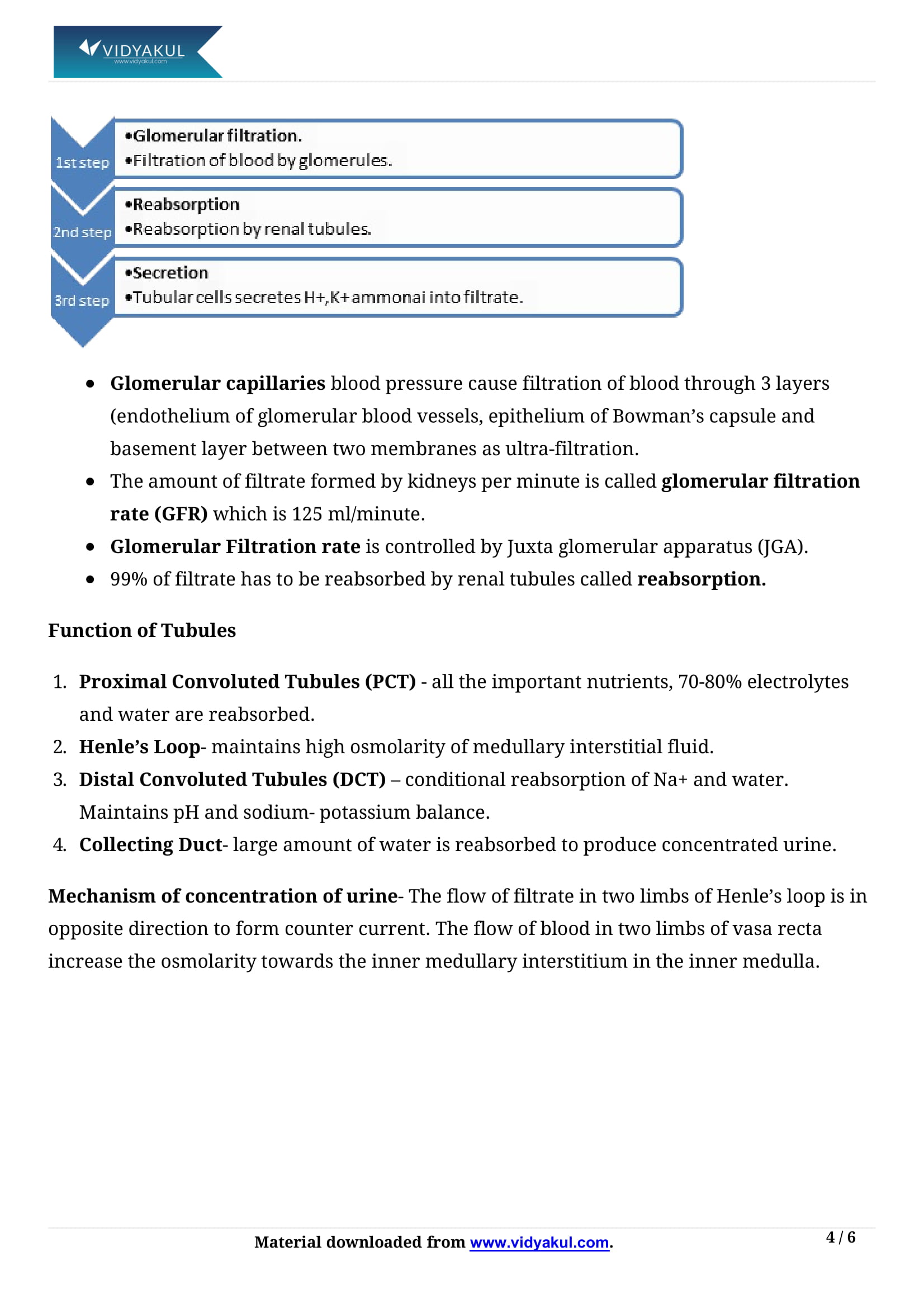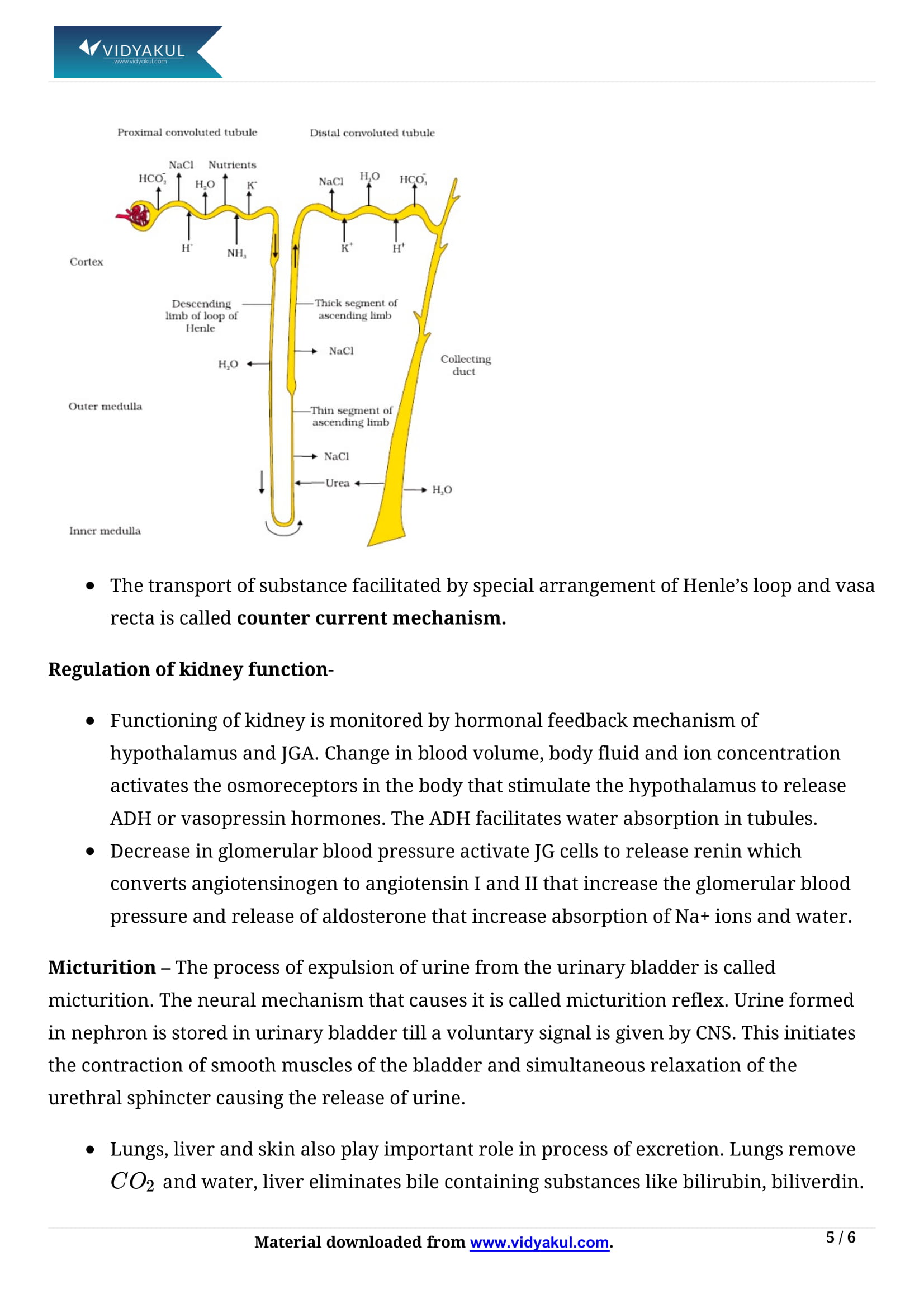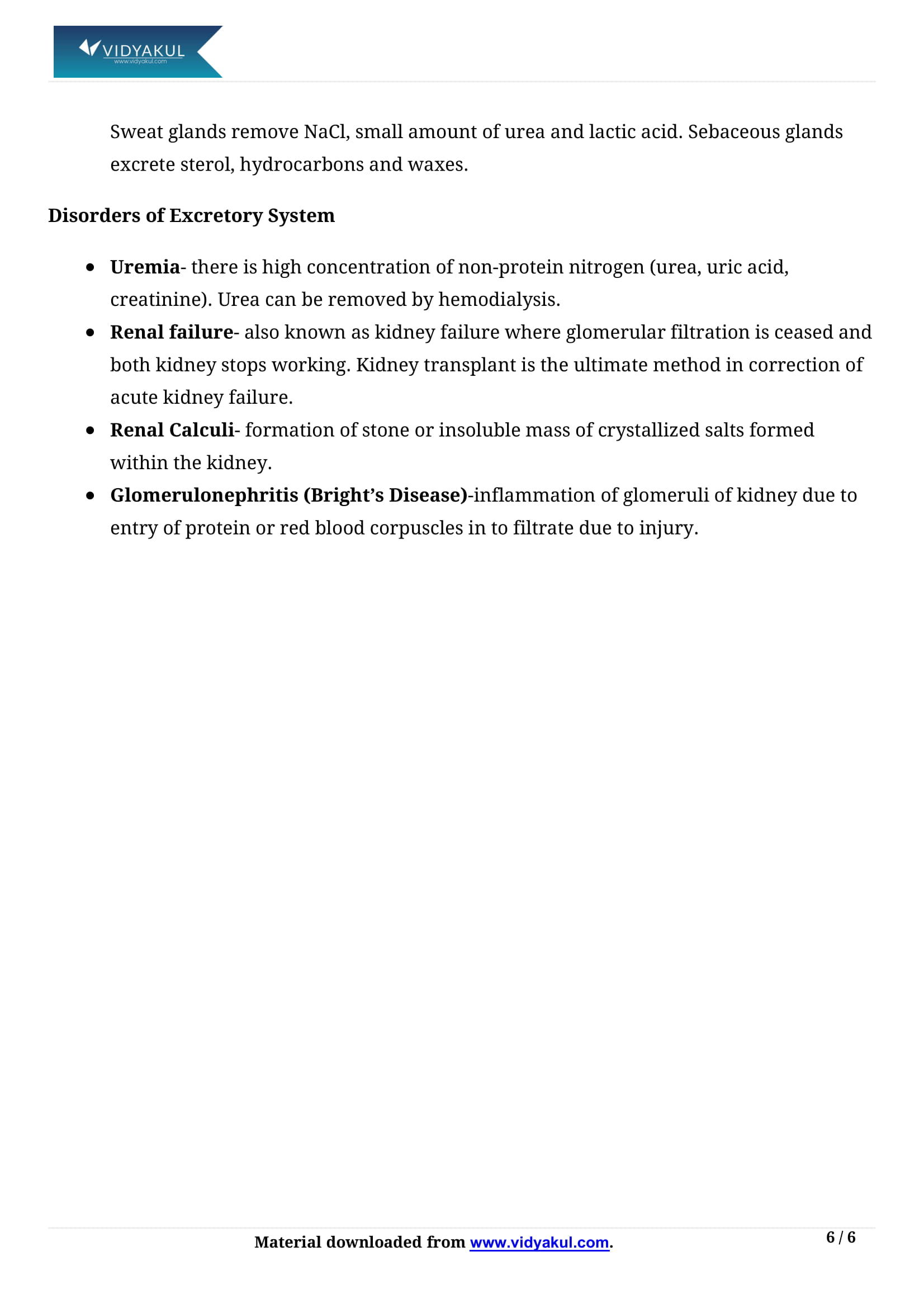Excretory Products and their Elimination Class 11 Notes

Chapter 19 Excretory Products and their Elimination
Feces and excrement are valuable resources to help students do well on exams. Vidyakul experts created these NCERT notes after extensive research to provide a solid and accurate theory for Year 11 students. According to the most recent CBSE Curriculum 2022-2023, the notes provided will help students understand concepts in simple and understandable language.
Chapter 19 of NCERT notes for Grade 11 Biology provides students with a solid foundation to achieve high scores on a variety of tests. A correct understanding of this chapter will help you do better on the exam. Continue reading this article to understand the subject matter of this chapter in detail.
CBSE CLASS 11 BIOLOGY CH-19
Points to Remember
Types of Nitrogenous Excretion
Depending upon the nature of excretory product, animals exhibit different processes of nitrogenous excretion.
These are described as follows
(i) Ammonotelism Ammonia is the most toxic form of nitrogenous waste, it requires large amount of water for its elimination. The organism that excrete ammonia are called ammonotelic and this , process to eliminate ammonia is known as ammonotelism.
Examples of ammonotelic animals are Many bony fishes, aquatic amphibians and aquatic insects. Ammonia, as it is readily soluble, is generally excreted by diffusion across body surfaces or through gill surfaces (in fish) as ammonium ions.
Kidneys does not play any significant role in its removal.
(ii) Ureotelism The process of excreting urea is called ureotelism. Animals, which does not live in high abundance of ‘water convert ammonia produced in the body into urea (in the liver) and release into the blood, which is filtered and excreted out by the kidneys.
Examples of ureotelic animals are Mammals, many terrestrial amphibians and marine fishes.
(iii) Uricotelism The process of excreting uric acid is called uricotelism. Uric acid, being the least toxic nitrogenous waste can be removed with a minimum loss of water from the animal body.
Thus, it is excreted in the form of pellet or paste (i.e., semi-solid form). Normally, the animals which live in desert exhibit uricotelism.
Examples of uricotelic animals are Reptiles, birds, land snails and insects.
Excretory Organs
Different animal groups have a variety of excretory structures (organs) to perform the process of excretion. In most of the invertebrates, these structures are simple tubular form, whereas, vertebrates have complex tubular organs called kidneys.
Topics and Sub-topics
Finding the right books and notes usually becomes daunting with the abundance of options available on the Internet. Before getting into the detailed NCERT notes for 11th Biology chapter 19, let us have a look at the sections and sub-sections of this chapter:
Frequently Asked Questions
Explain the micturition and disorders of the excretory system.
In micturition, urine is formed by the nephrons that are transferred by the urinary bladder which stores in until a signal is generated by the CNS. The signal is triggered by the stretching of the urinary bladder due to the filling of urine, which is responded in the form of signals to the CNS by the stretch receptors present on the bladder walls. To trigger smooth contractions of the bladder muscles, the CNS transfers motor messages and parallelly relaxes the urethral sphincter thereby resulting in the release of urine. This phenomenon of releasing urine is called as micturition The following are the disorders:
Kidney malfunction can cause urea accumulation in the blood, the condition is referred to as uremia that may lead to kidney failure. Urea in such patients is eliminated through hemodialysis and kidney transplantation ultimately.
Renal Calculi is when insoluble or stones of crystallized salts are formed within the kidney.
Inflammation of the glomeruli of the kidney – Glomerulonephritis
What is the role of tubular secretion in maintaining acid-base and ionic balance in the body fluids?
The tubular cells produce ammonia, H+, and K+ into the filtrate during the formation of urine. Tubular secretion assists in maintaining ionic and acid-base balance in the body fluids and is a necessary step in urine formation. The PCT helps in doing so through selective secretion of ammonia, hydrogen ions, and potassium ions into the filtrate. The DCT is also able enough to selectively secrete ions of potassium and hydrogen and ammonia for the maintenance of the sodium-potassium balance pH in the blood. Another structure that plays a role in maintaining the pH and ionic balance of the blood by selectively secreting H+ and K+ ions is the collecting duct.
Explain why in the loop of Henle, the glomerular filtrate gets concentrated in the descending limbs and diluted in the ascending limbs.
The thin wall of the Henle’s loop is permeable to water and not solutes. While the isotonic tubular fluid passes down the limb, it slowly loses its water through the exosmosis caused by increased osmolarity of the medullary interstitium from which the limbs stretch. Hence the filtrate tends to become hypertonic to the blood plasma. The ascending limb of the loop of Henle is permeable to ions of K+, Na+, Cl-, partially permeable to urea, and are impermeable to water. So, in the thick ascending limb of the loop of Henle, Ca, Mg, Cl, K, Na is reabsorbed, thereby causing the filtrate to become hypotonic to blood plasma and diluted in comparison to descending limb.
Define the following term with examples?
Ammonotelic organisms.
Uricotelic organisms.
Ureotelic organisms.
Ammonotelic organisms: They are the organisms which excrete nitrogenous waste substances in the form of ammonia. Ammonotelic organisms include Bony fishes, Sepia, Octopus etc.
Uricotelic organisms: They are the organisms which excrete nitrogenous waste substances in the form of uric acid. Birds, Uricotelic organisms include lizard, insects, etc.
Ureotelic organisms: They are the organism which excretes nitrogenous waste substances in the form of urea. Ureotelic organisms include cartilaginous fish, few bony fishes, adult amphibians and mammals including humans.
Practice Questions
Why is the hemodialysis unit called an artificial kidney? Explain.
What is the remedial measure advised for the correction of acute renal failure? Explain briefly.
Explain why the composition of glomerular filtrate is not the same as urine.
Give reason why aquatic animals ate mostly ammonotelic in nature whereas terrestrial forms are not.
Describe the role of Renin-Angiotensin in the management of Kidney function.
Types of Nitrogenous Excretion
Excretory Organs
Explain the micturition and disorders of the excretory system.
Kidney malfunction can cause urea accumulation in the blood, the condition is referred to as uremia that may lead to kidney failure. Urea in such patients is eliminated through hemodialysis and kidney transplantation ultimately.
Renal Calculi is when insoluble or stones of crystallized salts are formed within the kidney.
Inflammation of the glomeruli of the kidney – Glomerulonephritis
What is the role of tubular secretion in maintaining acid-base and ionic balance in the body fluids?
Explain why in the loop of Henle, the glomerular filtrate gets concentrated in the descending limbs and diluted in the ascending limbs.
Define the following term with examples?
Ammonotelic organisms.
Uricotelic organisms.
Ureotelic organisms.
Ammonotelic organisms: They are the organisms which excrete nitrogenous waste substances in the form of ammonia. Ammonotelic organisms include Bony fishes, Sepia, Octopus etc.
Uricotelic organisms: They are the organisms which excrete nitrogenous waste substances in the form of uric acid. Birds, Uricotelic organisms include lizard, insects, etc.
Ureotelic organisms: They are the organism which excretes nitrogenous waste substances in the form of urea. Ureotelic organisms include cartilaginous fish, few bony fishes, adult amphibians and mammals including humans.
Why is the hemodialysis unit called an artificial kidney? Explain.
What is the remedial measure advised for the correction of acute renal failure? Explain briefly.
Explain why the composition of glomerular filtrate is not the same as urine.
Give reason why aquatic animals ate mostly ammonotelic in nature whereas terrestrial forms are not.
Describe the role of Renin-Angiotensin in the management of Kidney function.
Learn more about it in Excretory Products and their Elimination Class 11 Notes pdf.
Download this solution for FREE Download this PDF
Download Vidyakul App for more videos, PDF's and Free video lectures.









